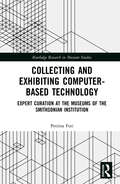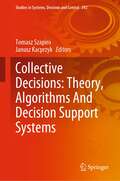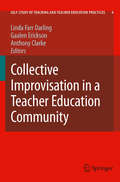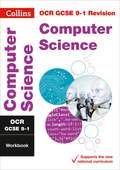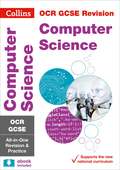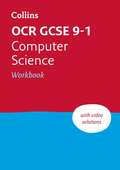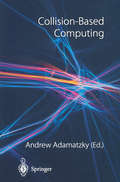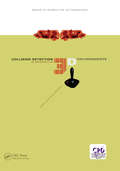- Table View
- List View
Collecting and Conserving Net Art: Moving beyond Conventional Methods
by Annet DekkerCollecting and Conserving Net Art explores the qualities and characteristics of net art and its influence on conservation practices. By addressing and answering some of the challenges facing net art and providing an exploration of its intersection with conservation, the book casts a new light on net art, conservation, curating and museum studies. Viewing net art as a process rather than as a fixed object, the book considers how this is influenced by and executed through other systems and users. Arguing that these processes and networks are imbued with ambiguity, the book suggests that this is strategically used to create suspense, obfuscate existing systems and disrupt power structures. The rapid obsolescence of hard and software, the existence of many net artworks within restricted platforms and the fact that artworks often act as assemblages that change or mutate, make net art a challenging case for conservation. Taking the performative and interpretive roles conservators play into account, the book demonstrates how practitioners can make more informed decisions when responding to, critically analysing or working with net art, particularly software-based processes. Collecting and Conserving Net Art is intended for researchers, academics and postgraduate students, especially those engaged in the study of museum studies, conservation and heritage studies, curatorial studies, digital art and art history. The book should also be interesting to professionals who are involved in the conservation and curation of digital arts, performance, media and software.
Collecting and Exhibiting Computer-Based Technology: Expert Curation at the Museums of the Smithsonian Institution (Routledge Research in Museum Studies)
by Petrina FotiComputer technology has transformed modern society, yet curators wishing to reflect those changes face difficult challenges in terms of both collecting and exhibiting. Collecting and Exhibiting Computer-Based Technology examines how curators at the history and technology museums of the Smithsonian Institution have met these challenges. Focusing on the curatorial process, the book explores the ways in which curators at the institution have approached the accession and display of technological artifacts. Such collections often have comparatively few precedents, and can pose unique dilemmas. In analysing the Smithsonian’s approach, Foti takes in diverse collection case studies ranging from DNA analyzers to Herbie Hancock’s music synthesizers, from iPods to born-digital photographs, from the laptop used during the filming of the television program Sex and the City to "Stanley" the self-driving car. Using her proposed model of "expert curation", she synthesizes her findings into a more universal framework for undertanding the curatorial methods associated with computer technology and reflects on what it means to be a curator in a postdigital world. Collecting and Exhibiting Computer-Based Technology offers a detailed analysis of curatorial practice in a relatively new field that is set to grow exponentially. It will be useful reading for curators, scholars, and students alike.
Collecting and Exhibiting Computer-Based Technology: Expert Curation at the Museums of the Smithsonian Institution (Routledge Research in Museum Studies)
by Petrina FotiComputer technology has transformed modern society, yet curators wishing to reflect those changes face difficult challenges in terms of both collecting and exhibiting. Collecting and Exhibiting Computer-Based Technology examines how curators at the history and technology museums of the Smithsonian Institution have met these challenges. Focusing on the curatorial process, the book explores the ways in which curators at the institution have approached the accession and display of technological artifacts. Such collections often have comparatively few precedents, and can pose unique dilemmas. In analysing the Smithsonian’s approach, Foti takes in diverse collection case studies ranging from DNA analyzers to Herbie Hancock’s music synthesizers, from iPods to born-digital photographs, from the laptop used during the filming of the television program Sex and the City to "Stanley" the self-driving car. Using her proposed model of "expert curation", she synthesizes her findings into a more universal framework for undertanding the curatorial methods associated with computer technology and reflects on what it means to be a curator in a postdigital world. Collecting and Exhibiting Computer-Based Technology offers a detailed analysis of curatorial practice in a relatively new field that is set to grow exponentially. It will be useful reading for curators, scholars, and students alike.
Collecting, Processing and Presenting Geoscientific Information: MATLAB® and Design Recipes for Earth Sciences (Springer Textbooks in Earth Sciences, Geography and Environment)
by Martin H. Trauth Elisabeth SillmannThis second edition is an intensively revised and updated version of the book MATLAB® and Design Recipes for Earth Sciences. It aims to introduce students to the typical course followed by a data analysis project in earth sciences. A project usually involves searching relevant literature, reviewing and ranking published books and journal articles, extracting relevant information from the literature in the form of text, data, or graphs, searching and processing the relevant original data using MATLAB, and compiling and presenting the results as posters, abstracts, and oral presentations using graphics design software. The text of this book includes numerous examples on the use of internet resources, on the visualization of data with MATLAB, and on preparing scientific presentations. As with the book MATLAB Recipes for Earth Sciences–4rd Edition (2015), which demonstrates the use of statistical and numerical methods on earth science data, this book uses state-of-the art software packages, including MATLAB and the Adobe Creative Suite, to process and present geoscientific information collected during the course of an earth science project. The book's supplementary electronic material (available online through the publisher's website) includes color versions of all figures, recipes with all the MATLAB commands featured in the book, the example data, exported MATLAB graphics, and screenshots of the most important steps involved in processing the graphics.
Collection Development in a Digital Environment: Shifting Priorities
by Sul H LeeLibrarians and other library professionals will find this informative book chock full of thought-provoking papers that will help you find new solutions to the collection development problems your library may experience while facing this new digital age. Collection Development in a Digital Environment is a result of papers presented at the 1998 University of Oklahoma Libraries Conference. You will discover ways to help your library take the lead in advancing the academic agenda through technology while at the same time leaning how technology requires change in the way libraries themselves operate. Collection Development in a Digital Environment explores ethical and technological dilemmas of collection development and gives several suggestions on how your library can successfully deal with these challenges and provide patrons with the information they need.This guide covers many valuable ways that your library can be better prepared for developing a “user friendly” collection of materials in this new digital age. You will discover how methods to shift your library from buying materials for collections for faculty or students that may need them sporadically to a system of responsiveness and customization where “just in time” and “just for you” are the standards of information access, making you and your library both time-effective and cost-effective. Collection Development in a Digital Environment brings to light many ways in which libraries can improve collection development methods, such as:using the Association of Research Libraries (ARL) initiatives to improve global access to information, such as the Global Resources Program, which features a seamless web of interconnected, coordinated, and interdependent research collections that are electronically accessible to usersexamining discussions on scenario-driven planning and the benefits of having your patrons let you know what they are interested in instead of guessing what materials they may be interested inanalyzing the influence of the World Wide Web on the role of libraries to discover how you can use these ideas to expand the collection of materials in your librarygaining insight into how the concept of disintermediation in the publishing process will help libraries use the electronic environment to eliminate intermediate sources and collect materials directly from the publisher, thus saving time and moneyFrom the insightful chapters in Collection Development in a Digital Environment, you will find new and successful ways to use the new digital environment to enhance collection development in your library. This unique book will help your library be more digitally accessible while still being user-friendly to your clientele.
Collection Development in a Digital Environment: Shifting Priorities
by Sul H LeeLibrarians and other library professionals will find this informative book chock full of thought-provoking papers that will help you find new solutions to the collection development problems your library may experience while facing this new digital age. Collection Development in a Digital Environment is a result of papers presented at the 1998 University of Oklahoma Libraries Conference. You will discover ways to help your library take the lead in advancing the academic agenda through technology while at the same time leaning how technology requires change in the way libraries themselves operate. Collection Development in a Digital Environment explores ethical and technological dilemmas of collection development and gives several suggestions on how your library can successfully deal with these challenges and provide patrons with the information they need.This guide covers many valuable ways that your library can be better prepared for developing a “user friendly” collection of materials in this new digital age. You will discover how methods to shift your library from buying materials for collections for faculty or students that may need them sporadically to a system of responsiveness and customization where “just in time” and “just for you” are the standards of information access, making you and your library both time-effective and cost-effective. Collection Development in a Digital Environment brings to light many ways in which libraries can improve collection development methods, such as:using the Association of Research Libraries (ARL) initiatives to improve global access to information, such as the Global Resources Program, which features a seamless web of interconnected, coordinated, and interdependent research collections that are electronically accessible to usersexamining discussions on scenario-driven planning and the benefits of having your patrons let you know what they are interested in instead of guessing what materials they may be interested inanalyzing the influence of the World Wide Web on the role of libraries to discover how you can use these ideas to expand the collection of materials in your librarygaining insight into how the concept of disintermediation in the publishing process will help libraries use the electronic environment to eliminate intermediate sources and collect materials directly from the publisher, thus saving time and moneyFrom the insightful chapters in Collection Development in a Digital Environment, you will find new and successful ways to use the new digital environment to enhance collection development in your library. This unique book will help your library be more digitally accessible while still being user-friendly to your clientele.
A Collection of AI Innovations by Chinese Teenagers: Discovering Youthful Ingenuity (Smart Computing and Intelligence)
by Yanyan Li Ronghuai Huang Jinbao Zhang Dejian LiuThis book presents 10 artificial intelligence (AI) innovation projects by Chinese teenagers, including innovations on intelligent medical care, environmental protection, education, transportation, among others. It delves into the technical details of these innovations, providing readers with a comprehensive understanding of the concepts and technologies involved in each case. The book also discusses the challenges faced by young innovators and their approaches to overcome them, and serves as a valuable resource for readers interested in the practical applications of AI.
Collective Agency and Cooperation in Natural and Artificial Systems: Explanation, Implementation and Simulation (Philosophical Studies Series #122)
by Catrin MisselhornThis book brings together philosophical approaches to cooperation and collective agency with research into human-machine interaction and cooperation from engineering, robotics, computer science and AI. Bringing these so far largely unrelated fields of study together leads to a better understanding of collective agency in natural and artificial systems and will help to improve the design and performance of hybrid systems involving human and artificial agents. Modeling collective agency with the help of computer simulations promises also philosophical insights into the emergence of collective agency.The volume consists of four sections. The first section is dedicated to the concept of agency. The second section of the book turns to human-machine cooperation. The focus of the third section is the transition from cooperation to collective agency. The last section concerns the explanatory value of social simulations of collective agency in the broader framework of cultural evolution.
Collective Behavior in Complex Networked Systems under Imperfect Communication
by Jianquan Lu Lulu Li Daniel W.C. Ho Jinde CaoThis book aims to explain how collective behavior is formed via local interactions under imperfect communication in complex networked systems. It also presents some new distributed protocols or algorithms for complex networked systems to comply with bandwidth limitation and tolerate communication delays. This book will be of particular interest to the readers due to the benefits: 1) it studies the effect of time delay and quantization on the collective behavior by non-smooth analytical technique and algebraic graph theory; 2) it introduces the event-based consensus method under delayed information transmission; In the meantime, it presents some novel approaches to handle the communication constraints in networked systems; 3) it gives some synchronization and control strategies for complex networked systems with limited communication abilities. Furthermore, it provides a consensus recovery approach for multi-agent systems with node failure. Also, it presents interesting results about bipartite consensus and fixed-time/finite-time bipartite consensus of networks with cooperative and antagonistic interactions.
Collective Decisions: Theory, Algorithms And Decision Support Systems (Studies in Systems, Decision and Control #392)
by Tomasz Szapiro Janusz KacprzykThis book is a token of appreciation for Professor Gregory E. Kersten (1949–2020), one of the most prominent and active researchers and scholars in the broadly perceived field of collective decisions, notably negotiations, the author of numerous influential papers, books, and edited volumes, a great scientist, mentor, and a loyal friend and colleague. This book contains some papers in the fields of group and collective decisions, voting, social choice, negotiations, and related topics, with examples of real applications. The authors are top researchers and scholars from all over the world whose life and academic career has been inspired and influenced by Professor Kersten.
Collective Excitations in the Antisymmetric Channel of Raman Spectroscopy (Springer Theses)
by Hsiang-Hsi KungThis thesis contains three breakthrough results in condensed matter physics. Firstly, broken reflection symmetry in the hidden-order phase of the heavy-fermion material URu2Si2 is observed for the first time. This represents a significant advance in the understanding of this enigmatic material which has long intrigued the condensed matter community due to its emergent long range order exhibited at low temperatures (the so-called “hidden order”). Secondly and thirdly, a novel collective mode (the chiral spin wave) and a novel composite particle (the chiral exciton) are discovered in the three dimensional topological insulator Bi2Se3. This opens up new avenues of possibility for the use of topological insulators in photonic, optoelectronic, and spintronic devices. These discoveries are facilitated by using low-temperature polarized Raman spectroscopy as a tool for identifying optically excited collective modes in strongly correlated electron systems and three-dimensional topological insulators.
Collective Improvisation in a Teacher Education Community (Self-Study of Teaching and Teacher Education Practices #4)
by Linda Farr Darling Gaalen Erickson Anthony ClarkeIt is the longevity of CITE that prompted the authors to turn their inquiries about teaching and learning to the challenges of sustaining their own project. The result is a collection that chronicles some of the lessons learned through their many experiences. The book represents multiple viewpoints on what counts as reform in teacher education and includes the voices of students (aspiring teachers) who are rarely asked to contribute to such projects.
Collective Intelligence and Digital Archives: Towards Knowledge Ecosystems
by Samuel Szoniecky Nasreddine BouhaïThe digitalization of archives produces a huge mass of structured documents (Big Data). Due to the proactive approach of public institutions (libraries, archives, administrations ...), this data is more and more accessible. This book aims to present and analyze concrete examples of collective intelligence at the service of digital archives.
Collective Intelligence and Digital Archives: Towards Knowledge Ecosystems
by Samuel Szoniecky Nasreddine BouhaiThe digitalization of archives produces a huge mass of structured documents (Big Data). Due to the proactive approach of public institutions (libraries, archives, administrations ...), this data is more and more accessible. This book aims to present and analyze concrete examples of collective intelligence at the service of digital archives.
Collective Intelligence Development in Business
by Patricia Bouvard Hervé SuzanneThis book analyses the development of Collective Intelligence by a better knowledge of the diversity of the temperaments and behavioural and relational processes. The purpose is to help the reader become a better Collective Intelligence Leader, who will be able to capitalize on the specificities and the differences of the individuals present in its collective, and transform these differences into complementarities, which are a source of wealth.
Collective Intelligence Development in Business
by Patricia Bouvard Hervé SuzanneThis book analyses the development of Collective Intelligence by a better knowledge of the diversity of the temperaments and behavioural and relational processes. The purpose is to help the reader become a better Collective Intelligence Leader, who will be able to capitalize on the specificities and the differences of the individuals present in its collective, and transform these differences into complementarities, which are a source of wealth.
Collective Online Platforms for Financial and Environmental Awareness: First International Workshop on the Internet for Financial Collective Awareness and Intelligence, IFIN 2016 and First International Workshop on Internet and Social Media for Environmental Monitoring, ISEM 2016, Florence, Italy, September 12, 2016, Revised Selected Papers (Lecture Notes in Computer Science #10078)
by Anna Satsiou Georgios Panos Ioannis Praggidis Stefanos Vrochidis Symeon Papadopoulos Christodoulos Keratidis Panagiota Syropoulou Hai-Ying LiuThis book contains the papers presented at the two CAPS (Collective Awareness Platforms for Sustainability and Social Innovation) workshops, namely the First International Workshop on the Internet for Financial Collective Awareness and Intelligence, IFIN 2016, and the First International Workshop on Internet and Social Media for Environmental Monitoring, ISEM 2016, held in Florence, Italy in September 2016. The two workshops were collocated with the third International Conference on Internet Science, INSCI 2016. The 8 papers presented have been carefully reviewed and selected from 13 submissions. The papers of the two workshops although targeting different goals aim at developing platforms promoting awareness on different but critical sustainability issues.
Collectives and the Design of Complex Systems
by Kagan Tumer David WolpertMany complex systems found in nature can be viewed as function optimizers. In particular, they can be viewed as such optimizers of functions in extremely high dimensional spaces. Given the difficulty of performing such high-dimensional op timization with modern computers, there has been a lot of exploration of computa tional algorithms that try to emulate those naturally-occurring function optimizers. Examples include simulated annealing (SA [15,18]), genetic algorithms (GAs) and evolutionary computation [2,3,9,11,20-22,24,28]. The ultimate goal of this work is an algorithm that can, for any provided high-dimensional function, come close to extremizing that function. Particularly desirable would be such an algorithm that works in an adaptive and robust manner, without any explicit knowledge of the form of the function being optimized. In particular, such an algorithm could be used for distributed adaptive control---one of the most important tasks engineers will face in the future, when the systems they design will be massively distributed and horribly messy congeries ofcomputational systems.
Collins GCSE 9-1 Revision — OCR GCSE 9-1 Computer Science Workbook (PDF)
by Collins GcseExam Board: Edexcel or OCR Level: GCSE 9-1 Subject: Computer Science First Teaching: September 2016; First Exams: June 2018 This Collins OCR Computer Science GCSE 9-1 Workbook contains topic-based questions as well as a full practice paper and answers. With lots of realistic practice opportunities for a variety of different exam-style questions. With a workbook and practice exam paper in one book, it contains plenty of practice opportunities to ensure the best results. Includes: • selection of questions covering each topic • topic-by-topic practice • complete exam-style paper
Collins GCSE 9-1 Revision — OCR GCSE COMPUTER SCIENCE ALL-IN-ONE REVISION AND PRACTICE (PDF)
by Collins Gcse StaffExam Board: Edexcel OR OCR Level & Subject: GCSE Computer Science First teaching: September 2016 First exams: June 2018 This Computer Science Revision and Practice guide contains clear and accessible explanations of all the GCSE content, with lots of practice opportunities for each topic throughout the book. Based on research that proves repeated practice is more effective than repeated study, this book is guaranteed to help you achieve the best results. There are clear and concise revision notes for every topic covered in the curriculum, plus seven practice opportunities to ensure the best results. Includes: * quick tests to check understanding * end-of-topic practice questions * topic review questions later in the book * mixed practice questions at the end of the book * free Q&A flashcards to download online * an ebook version of the revision guide * more topic-by-topic practice and a complete exam-style paper in the added workbook
Collins GCSE Grade 9-1 Revision — OCR GCSE 9-1 COMPUTER SCIENCE WORKBOOK: Ideal For Home Learning, 2023 And 2024 Exams
by Collins Gcse Paul ClowreyCollision-Based Computing
by Andrew AdamatzkyCollision-Based Computing presents a unique overview of computation with mobile self-localized patterns in non-linear media, including computation in optical media, mathematical models of massively parallel computers, and molecular systems. It covers such diverse subjects as conservative computation in billiard ball models and its cellular-automaton analogues, implementation of computing devices in lattice gases, Conway's Game of Life and discrete excitable media, theory of particle machines, computation with solitons, logic of ballistic computing, phenomenology of computation, and self-replicating universal computers. Collision-Based Computing will be of interest to researchers working on relevant topics in Computing Science, Mathematical Physics and Engineering. It will also be useful background reading for postgraduate courses such as Optical Computing, Nature-Inspired Computing, Artificial Intelligence, Smart Engineering Systems, Complex and Adaptive Systems, Parallel Computation, Applied Mathematics and Computational Physics.
Collision Detection in Interactive 3D Environments
by Gino van den BergenThe heart of any system that simulates the physical interaction between objects is collision detection-the ability to detect when two objects have come into contact. This system is also one of the most difficult aspects of a physical simulation to implement correctly, and invariably it is the main consumer of CPU cycles. Practitioners, new to the f

